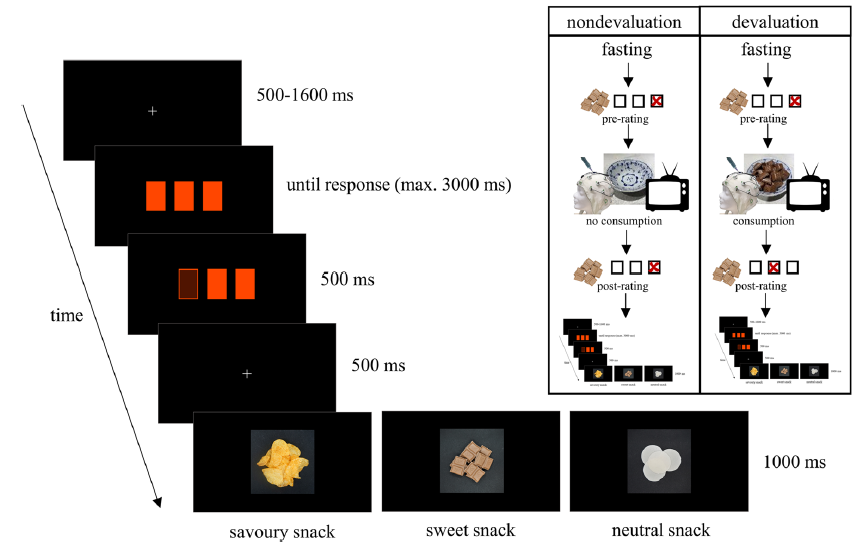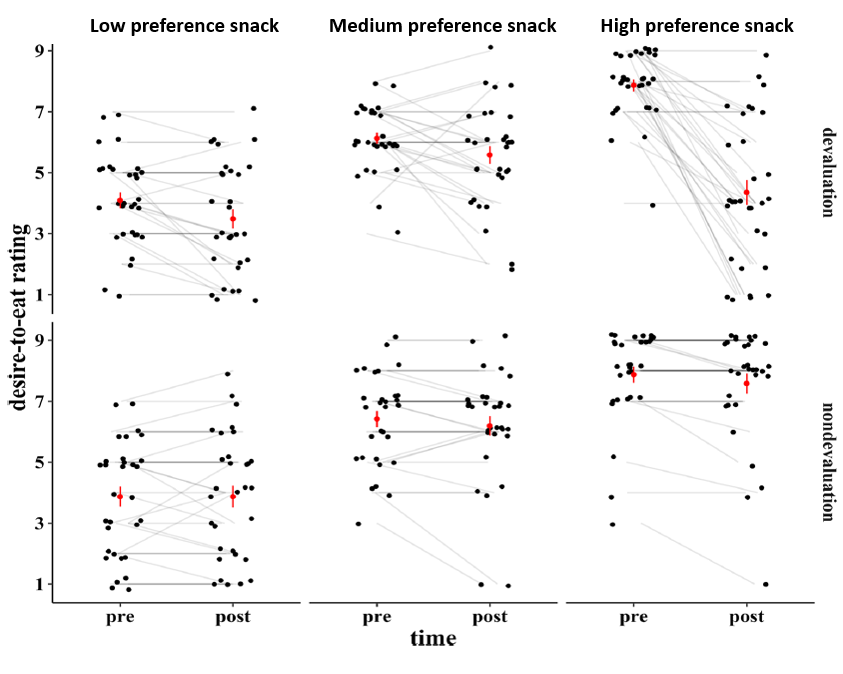We all enjoy a tasty snack every now and then, and we usually have personal preferences for specific foods. Some of us may prefer chocolate, whereas others prefer potato chips. Sometimes we may get a little carried away snacking, ending up eating way more than we intended. So, what happens in the brain when we have just eaten that whole bag of chips?
Dana Huvermann (Twitter), Christian Bellebaum, and Jutta Petersburs (Twitter) (pictured below) aimed to answer this question in their recent article published in the Psychonomic Society journal Cognitive, Affective, & Behavioral Neuroscience.

To do so, the authors investigated whether the representation in the event-related potential (ERP; i.e., small voltages generated in the brain in response to events or stimuli) can be manipulated through selective devaluation. Selective devaluation occurs when a specific food item is considered less desirable (i.e., devalued) after consumption. Thirty-four healthy adults underwent four phases: pre-ratings, devaluation or nondevalution, post-ratings, and a gambling task – procedure depicted below.

Pre-Ratings: First, participants fasted for at least 6 hours before coming into the laboratory. They then rated their hunger and made desire-to-eat ratings on a 1-9 scale for nine snack items from three categories: sweet (e.g., chocolate), savory (e.g., potato chips), and neutral snacks (e.g., rice cakes). The sweet (or savory) snack that a particular participant rated the highest was considered their high preference snack, the savory (or sweet) snack that received a medium rating was considered their medium preference snack, and the neutral snack with the highest rating was considered their low preference snack.
Devaluation or Nondevaluation: In the devaluation condition, participants were presented with a bowl containing their high preference snack and told to eat until they were full while they watched a TV show of their choice. The idea here was to selectively devalue the high preference snack item.
Approximately 11 days later, participants again came into the lab, but this time they did not consume their preferred snack (i.e., nondevaluation condition). The order of the devaluation and nondevaluation sessions was counterbalanced across participants.
Post-Ratings: Following either devaluation or nondevaluation, participants again rated their hunger and made desire-to-eat ratings for each snack. Participants indicated that they were less hungry after devaluation compared to nondevaluation. In addition, the desire-to-eat ratings for the high-preference snack fell after devaluation compared to nondevaluation (whereas ratings were consistent across time for the other snack types), indicating that the selective devaluation procedure was successful (see ratings below).

Gambling Task and EEG recording: Finally, participants completed a computerized gambling task while the electrical activity in their brain was recorded via electroencephalography (EEG). During this gambling task, participants saw three rectangles on screen and they could select one to see what snack was “hidden” behind it. After selecting a rectangle, one of three snacks (either their high, medium, or low preference snack) was displayed. Each snack was shown equally often in a random order, but participants did not know this – they were told that they could win the snack they discovered the most as a reward. Participants repeated this task for 300 trials.

What’s happening in the brain?
In general, subjective snack preferences were coded in the ERP (depicted above), with more positive amplitudes for more preferred snacks. Of particular interest is what happened in the P300 – an increase in amplitude from frontal and parietal brain areas peaking between 300 and 600 ms after presenting stimuli (in this case, a picture of a specific snack item) thought to be related to the motivational value of a particular stimuli. Specifically, selective devaluation reduced the amplitude in the P300 for the high-preference snack, so that it was less positive than the medium-preference snack. That is, neural processing of an anticipated reward is influenced not only by subjective snack preferences, but also one’s current motivational state.
According to Huvermann:
We found that the consumption of a certain snack until satiety is not only reflected in a reduced desire to eat the snack, but also modulates neural processing of the snack. Here, without consumption of the snack, the signal was largest for the participant’s favorite snack and smaller for less-preferred snacks, thus directly mirroring preference structures. This pattern changed when the favorite snack had been eaten until satiety: here, the signal decreased to the level of less preferred but still liked snacks, thus mirroring the decreased motivation for receiving the snack.
Chew on this
Even if you like chips more than chocolate, you may not be eager to eat more chips after you just consumed a whole bag. In fact, you might even reach for the chocolate bar before eating another chip. Huvermann and colleagues show that indulging in our favorite snacks can influence both our snack preferences and neural processing of those snacks. Importantly, their research provides exciting new avenues for exploring the neural mechanisms of overeating and obesity.
Featured Psychonomic Society article:
Huvermann, D.M., Bellebaum, C. & Peterburs, J. (2021). Selective devaluation affects the processing of preferred rewards. Cognitive, Affective, & Behavioral Neuroscience. https://doi.org/10.3758/s13415-021-00904-x
